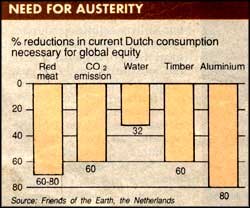My share of the earth
 Environmental space may be defined as the total quantity of natural resources that can be used on a sustainable basis, for example, the total quantity of carbon dioxide that can be released into the air by humans without damaging atmospheric processes like the global climate. To ensure equitable distribution of the total environmental space available, Northern countries should cut back their consumption levels to allow Southern countries to reach a common point of convergence in living conditions.
Environmental space may be defined as the total quantity of natural resources that can be used on a sustainable basis, for example, the total quantity of carbon dioxide that can be released into the air by humans without damaging atmospheric processes like the global climate. To ensure equitable distribution of the total environmental space available, Northern countries should cut back their consumption levels to allow Southern countries to reach a common point of convergence in living conditions.
In terms of land available for food production, to achieve a basic healthy diet for all the people on earth by 2010, the North must cut back on its meat consumption by 60 to 80 per cent. After conversion to sustainable agriculture, 0.25 ha of cropland is available per world citizen: 0.19 ha of this is necessary for a healthy diet. By comparison, an average Dutch person uses 0.45 ha, mainly because of a high meat consumption. Over the same period, the North has to cut down carbon dioxide emissions by 60 per cent and water use by 30 per cent to ensure that energy and water can be used equitably by all.
Related Content
- Debates that matter
- No time to lose, says Sunita Narain on the new IPCC report
- Future of weather and climate forecasting
- Making peace with nature: a scientific blueprint to tackle the climate, biodiversity and pollution emergencies
- International Waters
- CPCB report on steps to contain air pollution in India, 06/03/2020
